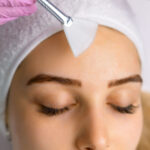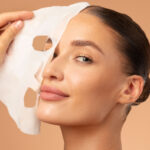
By Samantha Garcia
For many acne sufferers, the frustration does not end when the breakouts subside. Acne scars and post-inflammatory discoloration can linger for months or even years, serving as an unwanted reminder of past flare-ups. As estheticians, our role extends beyond treating active acne—we must also help clients heal and restore their skin post-breakout. Understanding the various types of acne scars and hyperpigmentation allows us to create targeted treatment plans that effectively reduce their appearance while supporting overall skin health.
Understanding Post-Acne Discoloration
Acne-related discoloration often falls into two main categories: post-inflammatory hyperpigmentation (PIH) and post-inflammatory erythema (PIE). While both can leave behind stubborn marks, their causes and treatments differ significantly.
Post-inflammatory hyperpigmentation (PIH) appears as dark brown or purplish spots that develop after a blemish heals. This occurs when inflammation triggers excess melanin production, leading to residual pigmentation in the skin. PIH is more prevalent in clients with medium to deep skin tones and can worsen with sun exposure if proper protection isn’t used.
Post-inflammatory erythema (PIE) presents as red or pink marks left behind after acne. Unlike PIH, which results from excess melanin, PIE is caused by dilated blood vessels that remain after inflammation subsides. Fair-skinned clients are more prone to PIE, and since it is vascular in nature, traditional brightening treatments like vitamin C or hydroquinone have little effect. Instead, treatments that promote vascular repair, such as LED therapy and microneedling, are more effective.
Treatment Strategies for PIH and PIE
For PIH, the goal is to regulate melanin production and accelerate cell turnover. Professional treatments such as chemical peels (especially those with glycolic, lactic, or mandelic acid), microneedling, and laser therapy can gradually lighten dark spots and improve skin tone. Topically, ingredients like azelaic acid, kojic acid, tranexamic acid, and vitamin C are excellent for breaking down pigmentation.
For PIE, treatments must focus on calming inflammation and improving vascular function. LED therapy, particularly red and near-infrared wavelengths, can help reduce redness by strengthening capillaries. Microneedling also works well by promoting new collagen and reducing dilated blood vessels. Niacinamide and green tea extract can be beneficial for clients looking for topical solutions that support vascular repair.
Atrophic Acne Scars
While discoloration eventually fades over time, atrophic acne scars—those that leave indentations in the skin—require more intensive treatment. These scars occur when inflammatory acne damages the deeper layers of the skin, leading to collagen degradation. There are three main types of atrophic acne scars:
- Ice-pick scars: Deep, narrow scars that extend into the dermis, resembling small punctures. These are the most challenging to treat and often require TCA Cross (trichloroacetic acid chemical reconstruction), microneedling, or laser resurfacing.
- Boxcar scars: Broader depressions with well-defined edges. These respond well to microneedling with platelet-rich plasma (PRP), radiofrequency microneedling, and fractional laser treatments that stimulate collagen production.
- Rolling scars: Wave-like depressions caused by tethered scar tissue pulling down on the skin. Treatments like subcision (a minor procedure that releases the scar tissue), microneedling, and dermal fillers can improve their appearance significantly.
Professional Treatments for Acne Scars
For clients dealing with both pigmentation and textural scarring, a multi-modality approach is often necessary. Some of the most effective professional treatments include:
Microneedling with PRP: By creating controlled micro-injuries in the skin, microneedling stimulates collagen production, while PRP (platelet-rich plasma) accelerates the healing process and enhances skin regeneration.
Microneedling with Stem Cells: Similar to PRP, microneedling with stem cells enhances collagen synthesis and accelerates skin repair. Stem cells provide powerful regenerative properties, helping to reduce inflammation, improve skin texture, and promote faster healing, making it an excellent option for acne scars and overall skin rejuvenation.
Chemical Peels: A series of chemical peels using mandelic acid, TCA, or Jessner’s solution can help improve both pigmentation and mild scarring.
Radiofrequency Microneedling (RF Microneedling): This combines microneedling with heat-based energy to further stimulate collagen production, making it highly effective for deeper scars.
Fractional Laser Resurfacing: For more severe scarring, fractional lasers like CO2 or erbium lasers can significantly improve skin texture, although they require more downtime.
Subcision and Fillers: For deep, tethered scars, subcision helps release the scar tissue, while hyaluronic acid fillers can temporarily plump depressed areas.
The Role of At-Home Skincare
While professional treatments play a crucial role in scar revision, at-home skincare is just as important in maintaining results and preventing new scars from forming. A well-rounded post-acne regimen should include:
Retinoids (Retinol, Tretinoin, or Adapalene): These encourage cellular turnover and stimulate collagen, helping to fade scars and improve texture over time.
Vitamin C: A potent antioxidant that brightens hyperpigmentation and supports skin healing.
SPF 30+ Daily: UV exposure can worsen PIH and slow scar healing, making daily sun protection essential.
Hydrocolloid Patches: For active breakouts, hydrocolloid patches can prevent picking and help reduce post-inflammatory marks.
Guiding Clients Through the Healing Process
The journey to scar-free skin requires patience, consistency, and professional guidance. As estheticians, we play a crucial role in educating clients on realistic expectations and long-term treatment plans. Acne scars can take months to improve, and results vary depending on the severity of scarring, skin type, and adherence to treatments.
By combining advanced in-clinic treatments with effective at-home care, we can help clients achieve smoother, more even-toned skin while restoring their confidence. Acne scars may tell a story of past breakouts, but with the right approach, they don’t have to define the future of a client’s skin.












